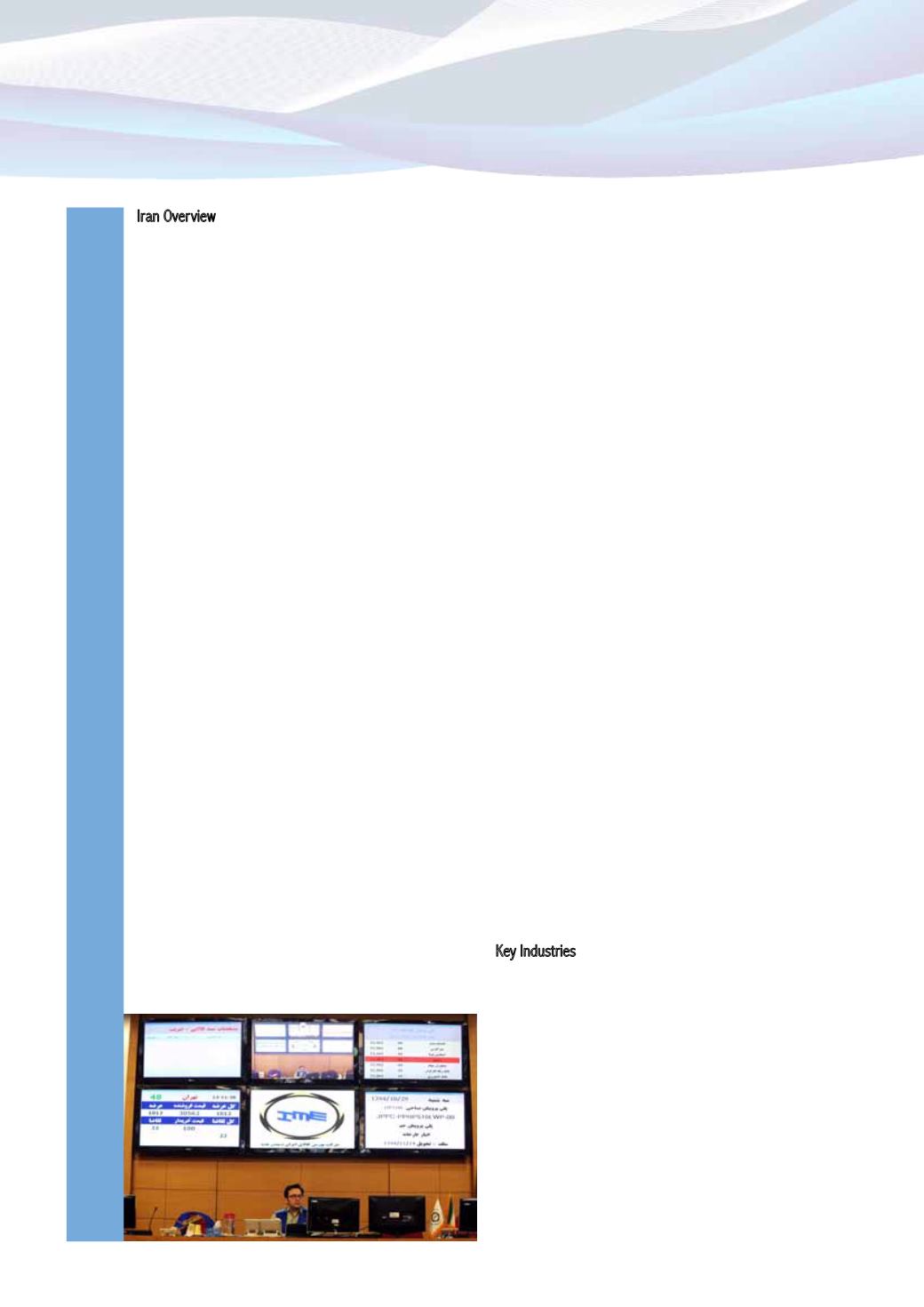
26
Iran Mercantile Exchange
–
continued
–
Iran Overview
Iran is the second largest economy in the Middle East
and North Africa (MENA) region after Saudi Arabia, with
an estimated Gross Domestic Product (GDP) in 2015 of
US$393.7 billion. It also has the second largest population
of the region after Egypt, with an estimated 78.8 million
people in 2015.
Iran’s economy is characterized by the hydrocarbon sector,
agriculture and services sectors, and a noticeable state
presence in manufacturing and financial services. Iran ranks
second in the world in natural gas reserves and fourth in
proven crude oil reserves. Economic activity and government
revenues still depend to a large extent on oil revenues and
therefore remain volatile.
Iran has adopted a comprehensive strategy encompassing
market-based reforms as reflected in the government’s 20-
year vision document and the sixth five-year development
plan for the 2016-2021 period. The plan is comprised of
three pillars, namely, the development of a resilient economy,
progress in science and technology, and the promotion of
cultural excellence.
On the economic front, the development plan envisages an
annual economic growth rate of 8 percent with reforms of
state-owned enterprises, the financial and banking sector, and
the allocation and management of oil revenues among the
main priorities of the government during the five-year period.
The Iranian government has implemented major reforms
of its subsidy program on key staples such as petroleum
products, water, electricity and bread, which has resulted in
a moderate improvement in the efficiency of expenditures
and economic activities. A second phase of subsidy reform
is being considered which would involve a more gradual fuel
price adjustment than previously envisaged and the greater
targeting of cash transfers to low-income households.
Following the economic recovery experienced in 2014*, the
Iranian economy is estimated to have advanced at an annual
growth rate of only 0.5 percent during the 2015 Iranian
calendar year (i.e., March 21, 2015-March 20, 2016).
This performance came in spite of the signing of the Joint
Comprehensive Plan of Action (JCPOA) in July 2016 and
the significant economic prospects it offered. Inflationary
pressures on the economy continued to abate under the less
accommodative monetary policy stance, with the Consumer
Price Index falling to 12.6 percent per annum in January
2016, from a peak of 45.1 percent in October 2012.
Stimulating private sector growth and job creation is a continued
focus for the government considering the number of workers
who should enter the labor market in the coming years, including
women and youth and the persistently high unemployment rate
(11.7 percent). Tackling youth unemployment in particular is a
pressing policy issue in line with the evolving demographic profile
of the country, which is characterized by more than 60 percent of
its population estimated to be under the age of 30 in 2013.
Due to the lifting of the sanctions and a more business-
oriented environment, real GDP growth is projected to reach
4.3 percent and 4.8 percent in 2016 and 2017, respectively.
On the production side, growth will be mainly driven by
higher hydrocarbon production. On the expenditure side,
consumption, investment and exports are expected to be the
main drivers. Notwithstanding the narrowing of the output
gap over the coming years, inflation is forecast to remain
moderate, by Iran’s standard. The lifting of sanctions, and in
particular the positive impact this will have on the banking
system, will significantly reduce international transaction
costs. Iran’s current account position is expected to turn into
a surplus in 2017, also primarily driven by rising oil exports.
The economic recovery came as a result of the partial lifting
of sanctions under the interim Joint Plan of Action (JPOA)
signed between Iran and the P5+1 (i.e., China, France,
Germany, Russia, the United Kingdom and the United States)
in November 2013, and the related rise in consumer and
business confidence.
(Source: World Bank)
Key Industries
Metals and Minerals: Having large resources of copper, aluminum,
rare metals and many other minerals, precious stones and iron
ore, Iran is the largest producer of steel products and copper in
the Middle East and North Africa (35 million tons annually).
Petrochemicals: having the world’s second largest gas
reserves, the country has developed a booming petrochemical
and chemical products industry producing over 45 million
tons of polymers, plastics and chemicals on an annual basis
exporting to various destinations across the globe.
Agriculture: Almost all grains, cereals, and main agriculture
products are produced in Iran. Total agro-production
amounts to over 100 million MT annually. Iran exported
wheat to other countries in 2016.


